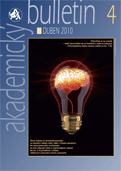International conference “The Present and Future of Institutions of Non-University Research”

28 May 2015
Non-university research has a future
The future of non-university research and its connection with higher education institutes, industrial research and business were the main themes of an international conference that the Czech Academy of Sciences organized on Wednesday, 27 May 2015 at its headquarters. The roundtable discussions were attended by the elite of European science – Martin Stratmann (president of the most important German scientific institution, the Max Planck Society), Peter Haslinger (director of the Herder-Institute, Leibniz Association), Soren Wiesenfeldt (director of research at the Helmholtz Association), Ed Noort (vice-president of ALLEA – All European Academies) and other guests from Italy, Great Britain and the USA.
The Czech Academy of Sciences at EXPO 2015

22 May 2015
On 1 May, the gates of the world EXPO 2015 with the motto “Feeding the Planet, Energy for Life” opened in Milan. The raising of the exposition’s flags was accompanied by the tones of Antonín Dvořák’s New World Symphony and precisely the Czech pavilion was selected by the Italian media as one of five to be recommended for a visit. Their last discoveries are then presented also by two institutes of the Czech Academy of Sciences. The Institute of Organic Chemistry and Biochemistry (IOCB) in the Laboratory of Life presents research aimed at seeking new human medications for lifestyle diseases. A human cell as a miniature chemical plant in which thousands of events take place necessary for the healthy functioning of the organism was rendered for the Laboratory of Life and the IOCB by the artist Jakub Nepraš.
Public Lecture with Nobel Laureate Finn Kydland

15 Apr 2015
Prof. Finn E. Kydland (University of California, Santa Barbara), 2004 Nobel Laureate in Economics, will give a public lecture on "Innovation and Capital Formation in Today's Policy Environment".
Jan Švejnar wins 2015 IZA Prize in Labor Economics

14 Apr 2015
The 2015 IZA Prize in Labor Economics goes to Jan Švejnar, the James T. Shotwell Professor of Global Political Economy and Director of the Center on Global Economic Governance at Columbia University’s School of International and Public Affairs, New York and a chairman of the Executive and Supervisory Committee of CERGE-EI in Prague. Czech economist was recognized for his work on economic issues in labor, development and the transition from socialist to market economies.
Prestigious European grant for a young scientist from the Institute of Molecular Genetics of The CAS

5 Mar 2015
The biologist doc. Mgr. Petr Svoboda, Ph.D., from the Institute of Molecular Genetics of The CAS acquires a significant grant from the European Research Council – the ERC Consolidator Grant. His project entitled D-FENS was selected from more than 2,500 proposals. The scientific work of Svoboda’s laboratory will hence be supported by EUR two million for the next five years. ERC Consolidator Grants are intended for young scientists, who obtained their doctorate between seven and twelve years before submission of their proposal, have distinctly above-average scientific results considering the given field and their career stage and prepare a high quality project with an original idea.
Scientists from The CAS have explained how plants turn light into heat

4 Mar 2015
The prestigious scientific journal Nature Chemical Biology has published an expert article of the scientific teams of Ing. Roman Sobotka, Ph.D., from the Institute of Microbiology of The CAS (Centre Algatech in Třeboň) and prof. RNDr. Tomáš Polívka, Ph.D., from the Biology Centre of The CAS and the University of South Bohemia in České Budějovice. Their breakthrough discovery describes the physical nature of the conversion of light radiation to heat, which takes place in light-harvesting complexes of plants. “They fulfil the role of kind of microscopic solar panels,” explains Ing. Roman Sobotka, Ph.D. However, if too much energy is absorbed, there is a threat of damage to the photosystems and light-harvesting complexes as a large part of the energy transforms into heat, through which they safely dispose of the energy. The mechanism of this occurrence was just discovered by scientists from The Czech Academy of Sciences.
Unveiling the mechanism of plant nutrition with nitrogen

2 Mar 2015
Ing. Klára Hoyerová, Ph.D., RNDr. Martin Kubeš, Ph.D., and doc. RNDr. Eva Zažímalová, CSc., from the Institute of Experimental Botany of The CAS took part in the newly published article of the prestigious journal Nature Plants. Their research focused on nitrogen – that is the essential building block of plant nutrition and when there is a lack of it, not only chlorophyll production slows but also the growth of the stem and leaves. Nitrogen arrives at the cells of the root from the soil solution in the form of nitrate, namely through the transceptor NRT1.1/NPF6.3. “This protein is incorporated into the plasma membrane and, in addition to the ability to transport nitrate, it independently sends signals to detect the presence of nitrate. Already this dual function itself is unique in and of itself, but the possibility of NRT1.1/NPF6.3 does not end there. In addition to transporting nitrate, it can transfer the important plant hormone auxin across the plasma membrane,” explains Ing. Klára Hoyerová, Ph.D.
The results of the research by scientists from The CAS published in the prestigious journal Nature Communications

12 Feb 2015
What causes disruptions of chromosome division in mammalian eggs?
The team of Dr. Michal Kubelka, Dr. Andrej Šušor and Dr. Martin Anger from the Institute of Animal Physiology and Genetics of The CAS and their foreign colleagues have made a fundamental discovery of the cause of aneuploidy in eggs that affects as many as 35 % of women over age 35. The missing or additional chromosomes in the egg can inter alia lead to the emergence of Down’s syndrome. The scientific team discovered that the suppression of the function of the molecular pathway mTOR, which is responsible for the synthesis of specific proteins in the right place at the right time, or its disruption leads to genomic instability, even though the egg is capable of being fertilized by sperm.
Unique ability of tumour cells

28 Jan 2015
A tumour cell, whose mitochondria do not function because of missing mitochondrial DNA, can acquires these functional organelles from another cell, and thus restart cellular respiration and renew its tumour potential. This is a discovery that rewrites textbook science, notes the popularization web portal IFLScience.
An international scientific team under the guidance of prof. Jiří Neužil from the Institute of Biotechnology of the CAS and Griffith University in Australia in cooperation with researchers from the Malaghan Institute in Wellington, New Zealand has discovered that cancer cells deprived of mitochondrial DNA, after being introduced in the receptor (mouse), have the ability to “renew” their mitochondrial DNA by acquiring it from the cells of the host. This leads to the renewal of the mitochondrial function of the mitochondria in cancer cells. The results is that the cells again acquire the ability to create tumours. This fundamental discovery of the function of a cancer cell was published in the prestigious journal Cell Metabolism (see http://www.cell.com/cell-metabolism/abstract/S1550-4131(14)00554-3).
125 YEARS OF THE CZECH ACADEMIES OF SCIENCES (AND ARTS)

23 Jan 2015
On Friday, 23rd January, 125 years had passed since the foundation of the Czech Academy of Emperor Franz Josef I for Sciences, Literature and Art (ČAVU), the predecessor of today’s the Czech Academy of Sciences. This significant jubilee will be commemorated by the Czech Academy of Sciences with several ceremonial events, exhibitions and lectures throughout 2015. The founder and first president of ČAVU was Josef Hlávka, an architect, builder, politician and patron. The Masaryk Academy of Labour and the Czechoslovak Academy of Sciences later built on the activities of this institution.





